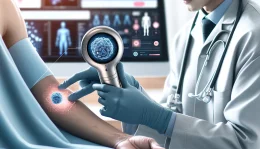Every year, it seems as if there’s a defining technology that emerges in the healthcare space and makes a name for itself. This year, there hasn’t been a single technology that’s emerged – rather there’s been a list of different tools, systems, and innovations that have changed the face of the industry. Strategic implementation of these tech trends will lead the way forward.
5 Healthcare Tech Trends to Watch
Each year, billions of dollars are poured into healthcare innovation. Most of the innovation doesn’t pan out, or fails to live up to expectations. However, now and then something new emerges and transforms the face of the industry. From direct patient care to the business and administrative side of things, here are some of the trends that are actually making an impact:
1. Healthcare IT Security
Healthcare companies are often the targets of sophisticated, well-coordinated cyber attacks. Because of the private nature of the data, as well as the depth of information stored by healthcare providers, hackers spend more time planning for and executing these attacks. This creates a pressing need for better IT security, and many healthcare companies are responding by investing in advanced security technologies.
“While policies are a critical part of any robust information security program, healthcare organizations should not rely solely on a policy document when it comes to protecting patient data,” the C Spire Blog explains. “Rather, they should complement administrative controls (i.e. policies) with reasonable technical controls.”
Some of these reasonable technical controls include advanced data encryption, better data backups, and real-time security platforms that use artificial intelligence to detect and diffuse threats before they become detrimental.
2. Advanced Training Tools
It used to be that medical students and new residents had to either watch their peers perform procedures and learn through osmosis, or be thrown into the fire and do something for the first time when lives were on the line. Neither option was entirely safe or effective.
Today, advanced healthcare training supplies have entered the marketplace to prepare students, residents, and other inexperienced healthcare professionals with safe and effective environments to learn. These include things like ECG simulators, live AED units, and bleeding control training kits.
3. Telemedicine
“Digital health enables the elderly to age and live better in their own homes, using technology like fall-detection monitors. Telehealth and telemedicine will also be part of the digital health transformation as more states update their laws to expand access to those services,” industry insider Tayla Holman writes. “One area that is being expanded is telemental and telebehavioral health services.”
As Holman points out, one in five adult Americans suffers from mental illness, meaning telemental services will become even more beneficial in the coming years. Whether it’s using a smartphone application in the middle of a health crisis to self-soothe, or being able to video chat with a practitioner from the comfort of a patient’s own home, advances in this area will prove to be extremely helpful.
4. Artificial Intelligence
Artificial intelligence, on its own, has the ability to totally transform the healthcare industry for the better over the next three to five years. Tasks like scheduling, timesheet entry, paperwork, electronic health records, accounting, and even diagnosing patients can all be improved with AI.
One specific application point is the use of chatbots. These AI-powered software mechanisms can help healthcare providers cut down on the time-consuming nature of patient communication and streamline any tasks that don’t require direct human intervention. Advanced chatbots – known as conversational chatbots – may even be able to discuss health issues in-depth with patients and get them the best possible treatments available. (IBM’s Watson is currently helping doctors provide advanced treatment options for rare cancers.)
5. Wearable Devices
According to data from seed fund Rock Health, $3.5 billion was invested into 188 digital health companies over the first half of 2017. The number of wearables is projected to reach an astonishing 34 million by 2022.
The beauty of medical wearable devices is that they can provide healthcare teams with valuable information around the clock, even when a patient is at home or outside of the practitioner’s direct care. This provides better insights into health conditions and makes care more cost-effective for everyone involved.
Some of the more intriguing applications include cardiac monitoring, infant monitoring, fitness tracking, and even pain management.
The Future of Healthcare is Here
People always postulate about what the future of the healthcare industry has in store, but you don’t have to do too much guessing these days. We’re at an interesting point in the evolution of the industry where transformational innovations are emerging at record speeds. Pay attention and you’ll be able to identify them and understand exactly where the industry is headed.










